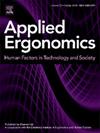Analysis of seat belt buckle release forces in post-rollover scenarios: Implications for passenger safety
IF 3.1
2区 工程技术
Q2 ENGINEERING, INDUSTRIAL
引用次数: 0
Abstract
Seat belts have been in use for nearly 140 years and have a proven track record to be the single most effective tool in reducing fatal and nonfatal injuries in motor vehicle crashes (MVCs). However, belted passengers still contribute to more than 40% of all MVC fatalities. The likelihood of severe injuries and fatalities is significantly greater in rollover crashes. The motivation behind this research is to address some of the contributing factors related to belted rollover fatalities. In the United States, they contribute to about 3% of all motor vehicle crashes but account for almost 30% of all fatalities. The objective of this study was to investigate the ability of adults to unlatch a push-button seat belt buckle in a rolled-over orientation. Fifty-five (55) out of sixty (60) subjects in this study (92%) were able to unlatch their seat belt while in a rolled-over orientation. However, 96% of the female subjects and 83% of the male subjects were unable to exert enough force to exceed the force requirement of 133N specified in Federal Motor Vehicle Safety Standard (FMVSS) No. 209 at any given orientation. For male subjects, a reduction of almost 22%, and for female subjects, a reduction of almost 13% in the mean push force from upright to rolled-over orientation was observed. Results of the study suggest that reducing the maximum buckle release force to 50 N would accommodate the strength capabilities of 95% of subjects to unlatch the seat belt buckle in any orientation. This study emphasizes the need for investigating seat belt standards and regulations, some of which have not been changed since their inception in 1965.
侧翻后安全带扣释放力分析:对乘客安全的影响
安全带已经使用了近140年,并且已被证明是减少机动车碰撞(MVCs)中致命和非致命伤害的最有效工具。然而,安全带乘客仍然占所有车祸死亡人数的40%以上。在侧翻事故中造成严重伤害和死亡的可能性要大得多。这项研究背后的动机是解决一些与安全带翻车死亡有关的因素。在美国,它们约占所有机动车事故的3%,但占所有死亡人数的近30%。这项研究的目的是调查成年人的能力,解开一个按钮安全带扣在翻转方向。在这项研究中,60名受试者中有55人(92%)能够在侧翻时解开安全带。然而,96%的女性受试者和83%的男性受试者在任何给定方向上都无法施加足够的力,超过联邦机动车安全标准(FMVSS)第209号规定的133N的力要求。对于男性受试者,减少了近22%,对于女性受试者,从直立方向到翻转方向的平均推力减少了近13%。研究结果表明,将最大解扣力降低到50牛,可以满足95%的受试者在任何方向解开安全带扣的强度能力。这项研究强调了调查安全带标准和规定的必要性,其中一些标准和规定自1965年开始实施以来就没有改变过。
本文章由计算机程序翻译,如有差异,请以英文原文为准。
求助全文
约1分钟内获得全文
求助全文
来源期刊

Applied Ergonomics
工程技术-工程:工业
CiteScore
7.50
自引率
9.40%
发文量
248
审稿时长
53 days
期刊介绍:
Applied Ergonomics is aimed at ergonomists and all those interested in applying ergonomics/human factors in the design, planning and management of technical and social systems at work or leisure. Readership is truly international with subscribers in over 50 countries. Professionals for whom Applied Ergonomics is of interest include: ergonomists, designers, industrial engineers, health and safety specialists, systems engineers, design engineers, organizational psychologists, occupational health specialists and human-computer interaction specialists.
 求助内容:
求助内容: 应助结果提醒方式:
应助结果提醒方式:


